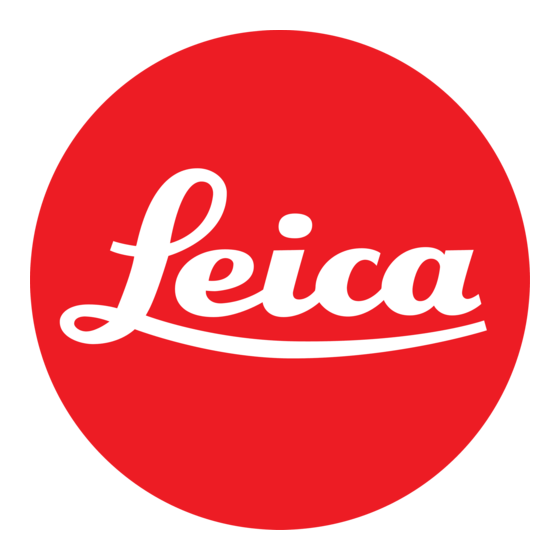

Leica TCS SP5 Manual
Hide thumbs
Also See for TCS SP5:
- User manual (50 pages) ,
- User manual (123 pages) ,
- User manual (166 pages)
Table of Contents
Advertisement
Quick Links
Download this manual
See also:
User Manual
Advertisement
Table of Contents

Summary of Contents for Leica TCS SP5
- Page 1 Cell Imaging Unit – UIC LEICA TCS SP5 MICROSCOPE MANUAL...
-
Page 2: Table Of Contents
TABLE OF CONTENTS ANATOMY OF THE LEICA SP5 CONFOCAL MICROSCOPE INITIALISATION PROCEDURE SP5 MICROSCOPE RIGHT SIDE OF MICROSCOPE (DETAILED VIEW) FRONT SIDE OF MICROSCOPE (DETAILED VIEW) LEFT SIDE OF MICROSCOPE (DETAILED VIEW) CONTROL PANEL BUTTONS STARTING THE LAS SOFTWARE CONFIGURE FOR ACQUISITION 1.1 THE LEFT PANEL ALLOWS YOU TO CONFIGURE THE IMAGE... -
Page 3: Anatomy Of The Leica Sp5 Confocal Microscope
ANATOMY OF THE LEICA SP5 CONFOCAL MICROSCOPE 1. Research inverted microscope 1. Transmitted light source 2. Scanhead 2. Stage 3. TCS Workstation 3. CLSM port 4. Microscope control unit 4. z -Drive 5. Laser and power supply 5. Display 6. Computer table 6. -
Page 4: Initialisation Procedure
3. Turn on the microscope 4. Log on into your personal/group account 5. Start the “Leica Confocal Software -LAS” available both as a Desktop shortcut and the Windows start menu. -
Page 5: Sp5 Microscope
SP5 MICROSCOPE The microscope is fully automated which means that you have now button in stead of knobs. It you know what you do in a conventional microscope, it takes 5 minutes to understand what the buttons are for. 1. RIGHT SIDE OF MICROSCOPE (DETAILED VIEW) Displays the following information: 1. -
Page 6: Front Side Of Microscope (Detailed View)
2. FRONT SIDE OF MICROSCOPE (DETAILED VIEW) Displays the following information: 1. Change cube for blue excitation filter cube – FITC, GFP 2. Change cube for green excitation filter cube – RFP, CY3 3. Use if for cutting some “umpolarized light” from the laser (might be interesting for good DIC) 4. -
Page 7: Control Panel Buttons
Displays the following information: 1. Change from transmitted light to transmitted light detector (not confocal detector) 2. Enables switching from oil to dry objectives and vice-versa, minimizing the risk of having oil in dry objectives 3. Move one filter cube position 4. -
Page 8: Starting The Las Software
THE LAS SOFTWARE 1. Double-click on the LAS AF icon to start the program. 2. In the window coming up check that MACHINE is selected under CONFIGURATION and START. 3. In the software window, go the CONFIGURATION tab, LASER and turn on the lasers you need 4. -
Page 9: The Left Panel Allows You To Configure The Image
1.1 THE LEFT PANEL ALLOWS YOU TO CONFIGURE THE IMAGE ACQUISITION PARAMETERS: • Acquisition type. Standard mode is XYZ. • Image size in pixel. Standard size is 512x512 and acceptable for publication, although in some instances 1024x1024 may be desirable for publication. -
Page 10: The Right Panel Allows You To Load A Pre-Made
1.2 THE RIGHT PANEL ALLOWS YOU TO LOAD A PRE-MADE CONFIGURATION OR TO CREATE YOUR OWN ONE 1.2.1 If you want to use a pre-made configuration, just use the drop down menu « Load/Save single settings »: Click here to select a pre-made configuration 1.2.2 If you want to create your own configuration, follow this step-by-... -
Page 11: Acquire Images
ACQUIRE IMAGES Once the acquisition configuration is done you can start to acquire images. The intensity of the image can be controlled by the laser intensity and the gain (amplification of photons) and offset (threshold) adjustment of the detector. Start preview scanning by clicking on LIVE. Enhance the gain until you see an image. -
Page 12: Acquiring A Z-Stack
ACQUIRING A Z-STACK Activate the Z-stack window. The cube represents the specimen. The yellow plane marks the current z-position. This position is specified in the field below the cube (z position µm). 7. 1 Set the z-stack range: Select the top and the bottom of the sample and define them by clicking into the Begin and End arrow which will than turn red. -
Page 13: Save And Export Your Images
frequency is not necessary. You can also define the number of images of a z- stack and the distance between them manually. SAVE AND EXPORT YOUR IMAGES The captured images displayed in the “Experiment” menu are not safely saved until you save them. -
Page 14: Shutdown Procedure
SHUTDOWN PROCEDURE 1. Log out and shut down the computer in windows. 2. Turn off the microscope. 3. Turn off the camera. 4. If you used the HBO light source and there is no one using the microscope for the next hour or you’re sure that the next user won’t use this light source, then turn the lasers off (in the key) and the fluorescence light power source off.








Need help?
Do you have a question about the TCS SP5 and is the answer not in the manual?
Questions and answers